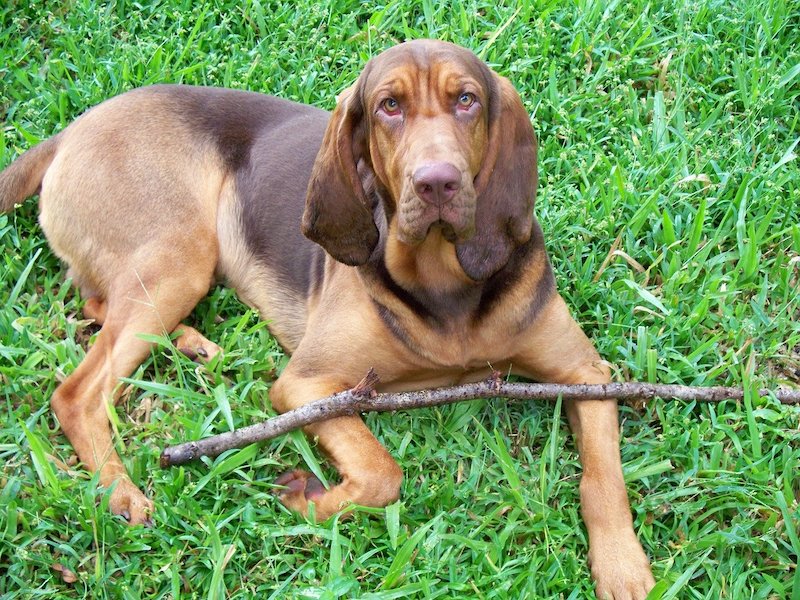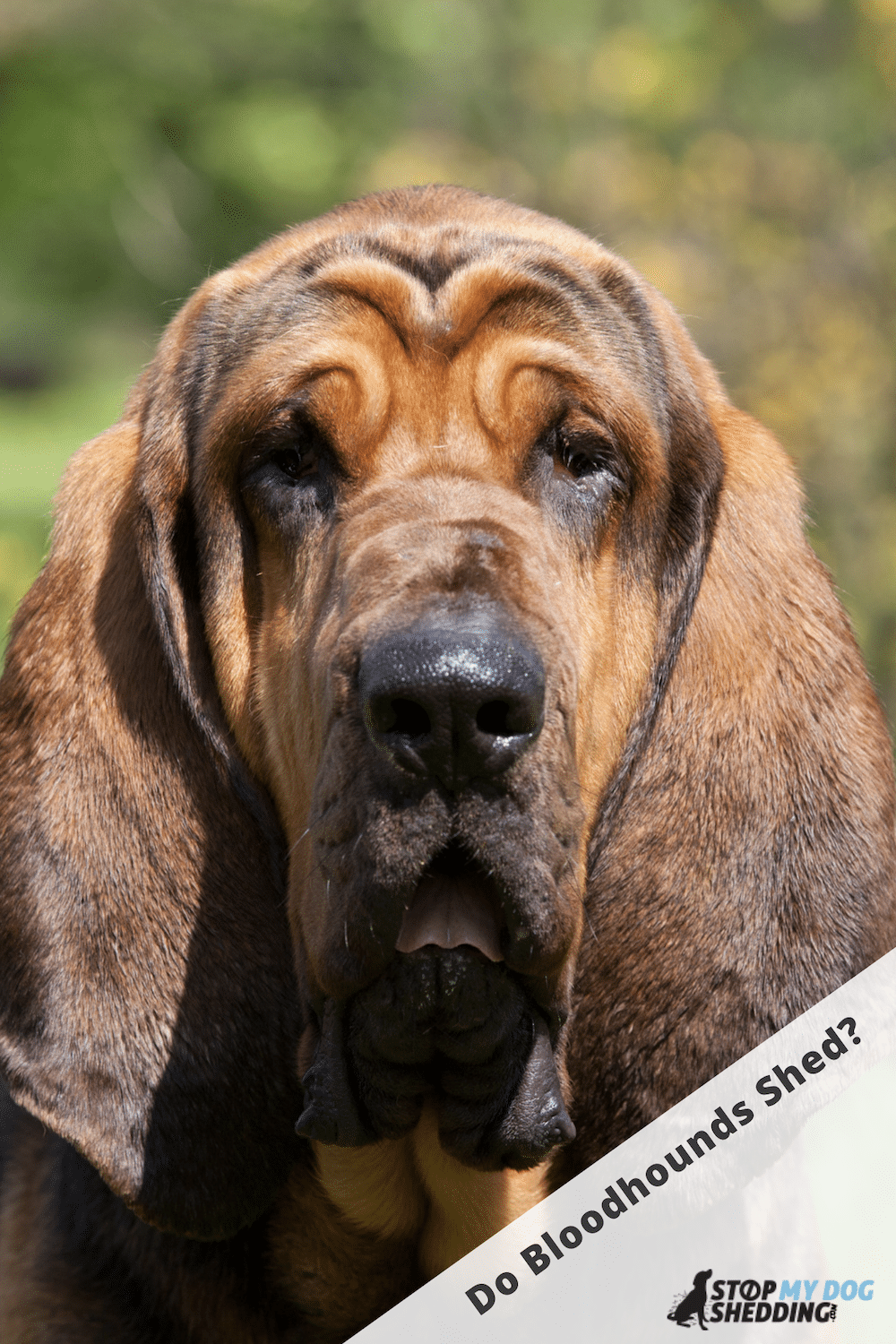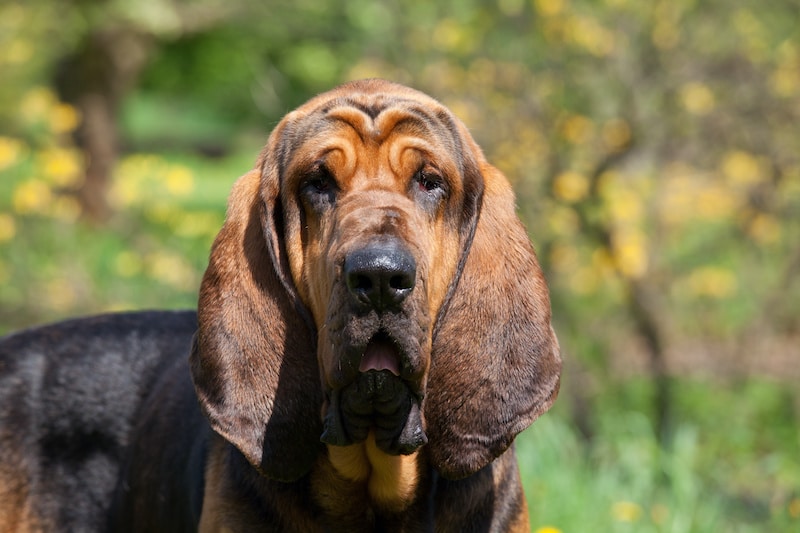Bloodhounds are large dogs that were bred for hunting and tracking. But they are best known for the latter, which they excel at given their inquisitive nature and incredible sense of smell. They also make relaxed, friendly companions.
Do they shed much? Yes, Bloodhounds shed a moderate-to-high amount. But the shedding is most noticeable once or twice per year, during spring and fall. Their coat is short and dense, so a bristle brush or rubber hound glove can help you maintain his coat and manage the shedding.
Let’s look a little closer at how much they shed, what they’re like to groom, and what you can do to keep the molting under control.
Recommended: Go here to see our top-rated dog hair blow dryers
Bloodhound Shedding – What to Expect
Bloodhounds are a moderate-to-high shedding breed.
They shed a similar amount to other large, short-coated dogs such as the Great Dane and Greyhound. But the shedding in a Bloodhound tends to be more seasonal in nature.
What does seasonal shedding mean?
Seasonal shedding occurs when a dog sheds more heavily during certain seasons, such as spring and autumn. And the reason they do this is because they are preparing for the change in climate.
For instance, it is common for most seasonal shedders to shed (or molt) their coat in spring as their thicker winter coat is not needed for the coming summer months.
Given how short his coat is, however, the shedding isn’t going to be as noticeable as a dog like the German Shepherd. And when their short hair falls out, it normally drops straight onto the floor instead of floating around, which can make it easier to manage.
So, to sum it up, they do shed.
You will notice some fur dropping out throughout most of the year, and an increase once or twice per year during shedding season, which normally lasts for about 2-3 weeks.
But the good news is, it’s not difficult to manage through proper grooming.
Recommended: Go here to see our top-rated dog hair blow dryers
Grooming Your Bloodhound
Grooming a Bloodhound is fairly simple.
They have short, dense coats that come in black and tan, liver and tan, and red. And brushing weekly with a bristle brush or rubber hound glove is normally enough to maintain their coat.
A bristle brush is a very common type of dog brush that is made up of soft, medium or hard bristles. And a medium variety works well for the Bloodhound. You could also use a rubber hound glove, or any type of rubber brush, which is basically just a glove with rubber on the side that grooms your dog.
Both of these brushes can work well for general coat maintenance. However, during shedding season, using a shedding blade or deshedding tool can make the task of grooming easier and more efficient.

So, overall, brushing them is fairly easy. A quick brush once or twice per week is normally enough to maintain their coat and remove much of the dead fur.
However, there is one aspect of grooming that isn’t so easy.
Given how droopy their skin is, they tend to drool a lot and therefore need regular wipe downs (especially around the face) and regular baths to stop them from developing a dog odor.
A simple baby wipe can work well for wiping him down after meals and exercise, and bathing with a good quality, preferably moisturizing, dog shampoo can make all the difference.
How to Reduce Excessive Shedding
It’s not possible to stop the shedding in a Bloodhound, or any dog, completely. But there are some very effective ways you can reduce the shedding and how much of the fur ends up gathering around the home.
And this mostly comes down to brushing, bathing and nutrition.
In some cases, however, excessive shedding can be caused by things like stress, hormones, fleas or allergies for example. So if you have any concerns at all, you should contact your veterinarian.
With that being said, let’s look at some of the ways you can reduce normal shedding in a healthy Bloodhound.
- Brushing: Regular brushing is one of the best ways to manage shedding. It removes the dead fur from his coat before it has a chance to fall out and also massages his skin. Which in turn spreads his skin oils and promotes a healthier, stronger coat. However, avoid brushing too often, especially with harsh shedding tools, as this can irritate his skin.
- Bathing: Regular bathing can help remove the old fur and is ideal to do prior to brushing as it softens the dead hairs. Just be sure to use a dog shampoo that doesn’t dry out his coat, as a dry coat is not helpful in the battle against shedding.
- Proper Nutrition: Choosing a good quality dog food can make a huge difference as to how much a dog sheds. Speak with your vet about selecting the right type of dog food and, if he is shedding due to a less than optimal diet, you’ll be amazed at the difference.
There are other great ways you can reduce shedding, but these are the main ways. And, depending on the dog, probably the most effective overall.
If you’re looking for a way to “boost” your results, there are some effective supplements out there. But you don’t need to spend a lot of money either. Simple things like virgin coconut oil can work just as well.
At the end of the day, you can’t stop shedding completely. Almost all dogs do this to some extent. It is a very natural, healthy process of replenishing their hair. But thankfully there are some ways you can manage it, to keep your home as free from dog hair as possible.
Related Questions
Are Bloodhounds Hypoallergenic?
No. Bloodhounds are not a hypoallergenic breed. No dog is really, but some are more suitable for allergy sufferers than others, and the Bloodhound isn’t one of them.
Do Bloodhounds Drool Much?
Bloodhounds are known for drooling a fair bit, yes. This is largely because of the loose flappy skin around their face that collects saliva and water when they drink. They are similar to Mastiffs and Basset Hounds in this respect.
While this can be a bit annoying at times, it’s not difficult to manage. It can largely be kept under control simply by keeping some baby wipes on hand and wiping them down when needed. And what some do is use a scarf to keep as much off of the floors and furniture as possible.
When Do Bloodhounds Shed Most?
Bloodhounds tend to shed seasonally during times of the year like spring and fall, for about 2-3 weeks. This does differ from dog to dog though and where they live can make a difference. But if you notice an uptick in shedding during these seasons, this may be why.
Any Similar, Lower Shedding Dogs?
Some of the lowest shedding, easiest to groom alternative dogs in the “hound group” breed classification are Italian Greyhounds, Basenjis, and Salukis.













Please note: By submitting a comment using the above comment form, you confirm that you agree with the storage and handling of your data by this site as detailed in our Privacy Policy.